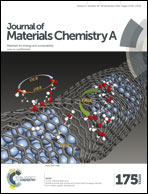Narrow bandgap conjugated polymers based on a high-mobility polymer template for visibly transparent photovoltaic devices†
Abstract
In this contribution, starting from a high mobility polymer P2 with a regioregular D–A–D–A structure, we set out to further optimize the optical bandgap and energy levels for photovoltaic applications. By introducing different donor segments to construct a modified D′–A–D–A backbone, we successfully synthesized three polymers named as PBT, PFT and PPT. Our results demonstrate that the rotation barrier between the D′ and A or D and A significantly increases after using asymmetric A unit PT, compared to either an asymmetric FBT unit or the original BT unit. So, PPT has a more planar backbone conformation, stronger intermolecular contacts and higher degree of structural order than PBT and PFT, and also possesses a deeper HOMO level. When blended with PC61BM, a fullerene acceptor, the PPT-based device showed a power conversion efficiency (PCE) of 7.3%, which is higher than that of PFT- (6.7%) and PBT-based (6.2%) devices; when blended with ITIC, a non-fullerene acceptor, the PPT-based device showed a PCE of 5.4%, which is also higher than that of the PFT (4.4%) and PBT-based (4.7%) device. Most importantly, we discover that these blends consisting of either PC61BM or ITIC as the electron acceptor exhibit an average transmission of ∼60% over the 400 to 600 nm range and a maximum transmission of ∼70% at ∼500 nm, which provides opportunities and possibilities of achieving high performance, stable and visibly transparent PVs in the future.



 Please wait while we load your content...
Please wait while we load your content...